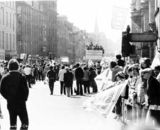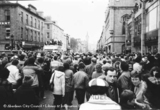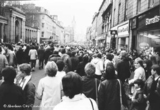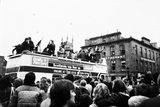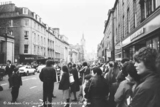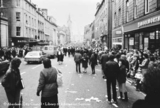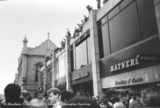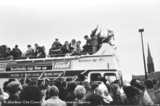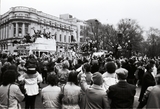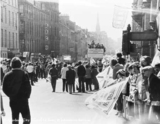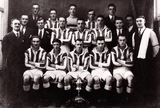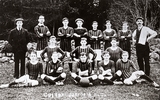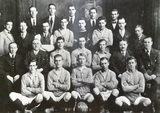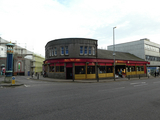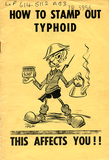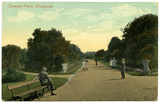|
Quick Search
|
Search Results
You searched for: More Like: 'Aberdeen Football Club European Cup parade'
61 items
items as
Pittodrie House
270 This photograph shows Pittodrie House which stands on the east slopes of Bennachie near the village of Pitcaple about 20 miles from Aberdeen. The Mither Tap is visible in the background.
Although the house stands over 680 feet above sea level, it is surrounded by trees which provide shelter from the wind. It is a complex house of several dates and was on the estate of the Knight Erskine family for centuries, before being sold in 1903 to George Smith, a Glasgow shipping magnate who founded the City Line of Steamers. The Smith family still own the property which has been run as a luxury hotel since 1977 and the 3000 acre estate is leased for agriculture.
The original house probably dated from around 1490, and a wheel stair from that period still survives, although the house was burnt by Montrose during the Covenanting Wars.
A date stone commemorates the re-building by the Erskines in 1675, and in 1841, the architect Archibald Simpson created the large neo-Jacobean extension with three storey balustraded tower on the east side - seen here covered in ivy. A billiard room was added in the early 1900s and further extensions took place in 1990.
The word 'Pittodrie' is thought to be derived from the Gaelic 'todhar' which can mean either manure or bleach. Aberdeen Football Club's ground is known as Pittodrie Stadium, because the Knight Erskines also owned the lands in the city where the stadium was built. Aberdeen Football Club League Champions 1979/80 parade
342 Aberdeen Football Club League Champions 1979/80 parade down Union Street Gala and Heather Day in the Duthie Park
395 This Adelphi Series postcard shows the Gala Day taking place in Duthie Park on 21st August 1915.
The Gala in Duthie Park and the accompanying Heather Day were both organised to raise funds for the Aberdeen Royal Infirmary.
The Gala Day is one of largest events ever to take place at the park. It was estimated that between 25,000 and 26,000 people attended. Tickets cost 6 pence (6d) for general admission and 2s 6d for carriages or motor cars.
Within the park there was an elaborate programme of entertainment and refreshments organised. Details of the programme were published in a 32 page booklet prior to the event. Upwards of 1,300 people took part in the programme.
Gates to the park opened at 3pm and the event officially commence at 3pm with a grand military parade. Lieut-Colonel A. H. Leith of Glenkindie, Garrison Commander, and Lord Provost James Taggart "took the salute" opposite the Hygiea statue.
The Gala and Heather Day were organised by a distinct committee; Taggart was its president and Alexander Findlay, Superintendent of Cleansing, was its chairman. Councillor H. J. Gray was the secretary and treasurer and Mr John Lints was his assistant. There were also conveners and secretaries for various sub-committees concerned with aspects like entertainment and refreshments.
There was a wide range of entertainment organised for within the park including singing, dancing, gymnastic displays, musical drill, motor cycle gymkhana and bayonet fighting. Various platforms saw performances from acts such as a company lead by D. M. Kinghorn, pierrots directed by Minnie Mearns, Dan Williams, and W. A. Craig's operatic choir. Charles Soutar lead a 500 strong choir of children from the city's public schools.
Practically all naval and military units present in the city were represented at the event and individuals from many of them took part in the sporting competitions. The day also included a 5-a-side football and tug of war competition. Preliminary matches for these took place prior to the day at Pittodrie Park.
The Gala Day was filmed and this was later shown as part of a special programme at the Picture House on Union Street from the 25th of the month.
Over £500 was taken at the gates for the event. Entertainment and refreshments within further increased the figure raised.
Heather Day itself generated another £474. This involved over 1,500 vendors going around all parts of the city selling sprigs of the plant. The sale started on the afternoon of the Friday and continued all through Saturday. Entertainment venues throughout the city were also visited.
The vendors were primarily young women and members of organisations like the boys brigade. Stores present in all areas of the city were replenished from a central depot at 173a Union Street. This in turn was supplied by the cleansing department buildings in Poynernook Road, where the preceding week had seen 200,000 sprigs prepared for sale. Peterhead, Inverurie, Ellon and Banchory organised their own Heather Days for the same fund.
The sum taken from both the Gala and the Heather Day was estimated at considerably over £1,000.
See the report in the Aberdeen Journal, Monday 23rd August 1915 page 8, for further details about the occasion. Aberdeen Football Club parade
643 Aberdeen Football Club parade down Union Street in an open topped bus after winning the European Cup in 1983. Aberdeen Football Club parade
644 Aberdeen Football Club parade down Union Street after winning the European Cup in 1983. Aberdeen Football Club European Cup parade
645 Aberdeen Football Club European Cup parade up Union Street in 1983. Aberdeen Football Club European Cup parade
646 Aberdeen Football Club European Cup parade up Union Street in 1983 Aberdeen Football Club European Cup parade
647 Aberdeen Football Club European Cup parade up Union Street in 1983 Aberdeen Football Club European Cup parade
648 Aberdeen Football Club European Cup parade up Union Street in 1983 European Cup Parade
652 Aberdeen Football Club's open top bus parade of the European Cup Winners' Cup in 1983. The photograph looks north west across Union Street towards its junction with Union Terrace.
Aberdeen defeated Real Madrid 2-1 in the final held in Gothenburg, Sweden on 11th May 1983.
The conquering heroes landed, cup in hand, at Aberdeen Airport at 14.40 the next day. The team received a rousing reception and were given a celebratory cake on arrival from an offshore catering company.
It was then on to the open top bus for the journey from Dyce to Pittodrie. Grampian Fire Brigade lined-up their engines outside their Anderson Drive headquarters as a unique guard of honour for the team as they headed for the city centre.
As shown here, the city streets were packed with fans of all ages, including some who had travelled back from Gothenburg.
Lord Provost Alex Collie, the Queen Mother and Margaret Thatcher all provided messages of congratulations. Celebrations ended at a teeming Pittodrie.
Aberdeen FC had another triumphant tour through the city centre only 10 days later after they beat Rangers 1-0 in the Scottish Cup Final at Hampden Park. The match was on the Saturday 21st May and the parade in Aberdeen was the next day. Aberdeen Football Club parade
662 Aberdeen Football Club parade on Union Street with European Cup, 1983 Culter
876 This image was taken around 1909 from a hill at the west end of Culter - 7 miles west from Aberdeen looking down on the North Deeside Road towards Banchory. The image shows the cottages known as Clayhills with the houses of Malcolm Road beyond. Hidden in the trees at the right hand side is the statue of Rob Roy overlooking the Leuchar Burn which runs through the wooded valley. Culter Football Club
883 A team photograph of Culter Football Club from the 1931-32 season.
Local historian Brian Coutts has been in touch with names for some of the people shown:
The fourth from the left,of the five men in the back row is David Sangster.
The middle row, of nine men, starts on the left with T. Emsie, the club secretary. 4th along is G. Petrie and the 5th is Arthur Jackson.
The front row, starting again from the left, is A.J. Moir, H. Wilson, L. Cooper, W. Jamieson and an unknown 5th man.
Brian also suggests that the trophy at the front might be the Archibald Cup. Culter Juniors Football Club, 1911
946 A team photograph of Culter Juniors Football Club in 1911.
Local historian Brian Coutts has been in touch with names of the individuals shown (all from left to right):
Back row - D. Guild, P. Low, J. MacDonald, W. Duncan, C. Dunbar, J. McAra, J. Milne and J. Ogilvie.
Middle Row (kneeling) - G. Insch, C. Allan and J. Milne.
Front row - J. Reid, Alastair Thomson, J. Agnew, G. McKenzie and J. Fraser.
Silver City Vault visitor David Allan suggests that the C. Allan in the middle row looks like his uncle, Charlie Allan, who lived in Culter's Clayhills cottages. Football at Pittodrie
1656 The large crowds visible in the photograph suggest that this may be the Scottish Cup semi-final of 21st March 1908. Reaching the semi-finals for the first time, Aberdeen played Celtic at Pittodrie before a record 20,000 attendance (this was prior to the introduction of neutral crowds). The Aberdeen players, seen here in their black and gold stripes of the time, lost 1-0 to the visitors. The Foundry
4409 A photograph of The Foundry pub and restaurant at 41-43 Holburn Street taken on 21st March 2024.
43 Holburn Street, today The Foundry, was built in around 1915/16 as a motor showroom and workshop for Mr. John Harper, engineer of Bournemouth, to a design by architect George B. Mitchell (Aberdeen Daily Journal, 20th September 1915, p. 4).
In November 1916, during the First World War, the Harper Motor Company put their new garage, at the junction of Holburn Street and Justice Mill Lane, at the disposal of the Red Cross. The commodious building, ideal for transport work, became the headquarters of the Aberdeen Transport Section of the Red Cross Society (Evening Express, 21st November 1916, p. 5).
43 Holburn Street was occupied and in use by the Harper Motor Company until at least 1979. In 1986, George Dowdles, who had ran a roller skating rink called Rollerland Disco in Bon-Accord Terrace, proposed to turn the premises into a leisure centre for teenagers (Press & Journal, 19th June 1986, p. 3).
The new venture at 43 Holburn Street was to be a soda and burger café modelled on the TV show Happy Days and called Up The Junction. It opened in October 1986 (P&J, 10th October 1986, p. 3).
Up The Junction appears to have struggled financially and 43 Holburn Street was remodelled and opened as Rollerland Mark II in August 1987 (EE, 22nd February 1988, p. 8). The original Rollerland skating rink had been on the second floor of 5 Bon-Accord Terrace and operated from 26th June 1981 to mid-1986.
Rollerland on Holburn Street was briefly owned by Cove Rangers football club and was temporarily renamed Wheels Leisure Centre. George Dowdles remained its manager (P&J, 1st April 1989, p. 1). The venue was reopened as Rollerland under the ownership of Aberdeen District Council in July 1989. DJs Robin Galloway and Gary Stein provided music for a reopening gala night (EE, 27th July 1989, p. 5).
Rollerland finally closed in February 1991 on safety grounds. Water leaks had warped the floor making it unsafe for skating. The venue had struggled financially and the estimated cost of repair was too large (P&J, 18th September 1991, p. 3). In June 1995, there was a significant fire in the building (EE, 19 June 1995, p. 2).
In September 1995, the company Alloa Pubs and Restaurants, who had leased the building from the District Council, unveiled plans for a £500,000 transformation of the run-down property. It was to be turned into a prestige bar-diner called The Granary, with a lay-out based on the company's Glasgow venue of the same name (EE, 16th September 1995, p. 7).
With a final redevelopment cost of £600,000, The Granary opened to the public on 6th February 1996 (P&J, 7th February 1996, p. 11).
A search of Aberdeen City valuation rolls indicates that by April 2005 The Granary had changed its name to The Foundry. At the time, The Foundry was operated by Mitchell & Butlers, one of the largest restaurant and pub businesses in the UK.
Mitchell & Butlers own the O'Neill's chain of Irish pubs, the first branch of which opened at 9-10 Back Wynd, Aberdeen on 22nd September 1994. This was formerly the premises of the Tappit Hen pub (P&J, 16th September 1994, p. 3).
In 2010, Mitchell & Butlers disposed of 333 of their town and community pubs to the Stonegate Pub Company. This likely included The Foundry ('Our history' page on Mitchell & Butlers website: https://www.mbplc.com/about-us/our-history/: accessed 22/03/2024).
In November 2023, The Foundry reopened to the public following a brief closure for a significant redevelopment. Backed by a £277,000 investment from the Stonegate Group, the UK's largest pub company, the work aimed to shift the venue from a sports-focused pub to a more family-friendly food destination. The exterior design changed from a black and gold colour scheme to the red and gold of Aberdeen Football Club (Aberdeen Business News, 23rd November 2023, https://aberdeenbusinessnews.co.uk/the-foundry-unveils-stylish-transformation-after-major-investment/: accessed 22/03/2024).
Treasure 12: How to Stamp Out Typhoid booklet
182 This booklet is a reminder of a troubled period in city's past. In 1964 Aberdeen suffered one of the largest outbreaks of Typhoid in recent British history. Over 500 people were admitted to city hospitals for treatment of the infectious disease. The majority of patients were quarantined for at least four weeks before being discharged. The outbreak was traced back to a contaminated tin of corned beef which was imported from Argentina, then chopped up and sold in the William Low grocer on Union Street.
Thankfully the outbreak was successfully contained and there were no fatalities. The all clear was given on 17th June 1964, 28 days after the first notification. Public health announcements played a significant part in the city's approach to tackling the outbreak. Dr Ian A. G. MacQueen, Aberdeen's Medical Officer of Health, became a well-known figure with regular appearances in print and on television and radio on the importance of good hygiene.
The How to Stamp out Typhoid booklet was the initiative of Aberdeen businessman R. A. Williamson. He was director of a wholesale firm that supplied small grocers in the north east and received many enquiries from his clients on how best to combat the outbreak. Williamson asked Macqueen who was unable to provide guidelines so, in collaboration with the health and welfare department, they created this 11 page health information booklet. It had a print run of 45,000 copies, was supported by Aberdeen Chamber of Commerce and illustrated by the Evening Express. The illustrations feature the paper's character Wee Alickie, a die-hard supporter of Aberdeen Football Club.
In the introduction MacQueen wrote:
"The Stopping of the typhoid outbreak is principally a matter of good personal hygiene by everyone, and particularly of good personal hygiene by all food handlers.
"In an effort to assist every section of the community in our area a short question and answer brochure has been hurriedly compiled, together with a Hygiene Check List, which should prove most useful to all establishments.
"Members of the Aberdeen Chamber of Commerce, food wholesalers, bacteriologists, health education officers and journalists have collaborated to rush this through. This brochure is therefore backed by their combined knowledge and experience. Please read it, study it and try to follow the advice that it gives."
The outbreak adversely affected Aberdeen's reputation in the UK and around the world. This in turn had an economic impact for the city, particularly on tourism. After the all clear was given the Queen came to the city to demonstrate that Aberdeen was a safe place to visit and that life had returned to normal.
Stewart Park
308 Opened in 1894, Stewart Park was named after the then Aberdeen Lord Provost, David Stewart. The area was land acquired from the Hilton Estate and was designed to be used by all ages. Three disused quarries were filled in and landscaped as small lakes stocked with fish.
Mrs Taylor, a widow of a Woodside merchant, left £500 to the park, especially for the purpose of becoming the Taylor Playground for children, in memory of her husband. Mrs Taylor was honoured with the memorial fountain by the Aberdeen Town Council.
Although the park may not have the small lakes, and fewer flower beds than when it first opened, it is still widely used, and as stated by the Lord Provost at the opening ceremony "It would be a thing of joy and beauty forever" to the people of Woodside.
Soon after the opening of Stewart Park, cricket clubs were formed. The park was home to many clubs, and memories of the park suggest that as many as twenty games of cricket would be in play at any one time. These games obviously paid off because Woodside Cricket Club won the Aberdeenshire Cup in 1957.
Other popular pursuits were the Woodside Football Club, the Grandholm Choir and the Woodside and District Cycling Club. The Cycling Club began in the early 30's, but had to disband during the Second World War. After the war, Joe Dunn, a cycle shop owner and a previous member, tried to restart the club.
This image is a James Valentine postcard. |




